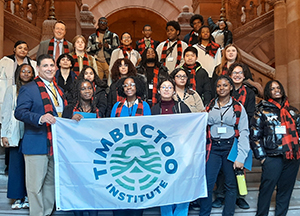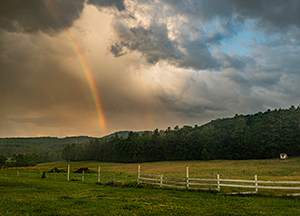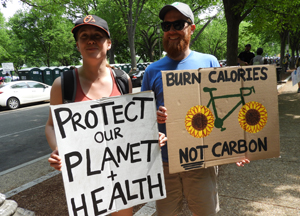
EPA to Reconsider “Do Nothing” Ozone Rule
Groups applaud step, urge stronger protections against dangerous smog pollution
Friday, October 29, 2021
Washington, D.C. -- On Friday, the Environmental Protection Agency (EPA) announced in a court filing that it will reconsider the National Ambient Air Quality Standards (NAAQS) for ground-level ozone, also known as smog. Under former President Trump, the previous EPA issued the flawed rule in late December 2020, leaving the outdated 2015 standards in place. Those standards set levels that were not protective of public health or the environment and allowed ozone pollution to persist in quantities that scientific studies show harms vulnerable populations and ecosystems.
While ozone is good as a protective layer in the stratosphere, ground-level ozone causes asthma attacks and other respiratory problems and contributes to climate change. It is linked to premature deaths and illness, damages plants and ecosystems, and stunts tree and crop growth. Formed by emissions from cars, trucks, and factories, ozone is also a greenhouse gas and curtailing it is a powerful way to help solve the climate crisis. Under the Clean Air Act, Congress required EPA to set National Ambient Air Quality Standards (NAAQS) to govern the atmospheric concentrations of common air pollutants, like ozone and particulate matter. The NAAQS set a baseline standard for air quality across the United States.
“The most recent science clearly shows that the current ozone standards are simply not strong enough to protect public health, or the crops, forests, and ecosystems we depend on,” said Marvin Brown, a lead Earthjustice attorney on the case. “Reconsidering the standards is a good first step, and now we urge the Biden administration to strengthen these standards using the best available science and ensure robust community input throughout the process.”
According to the American Lung Association’s 2021 State of the Air report, based on the current inadequate standard, more than 123 million people live in counties that have dangerous levels of ozone — many of which are disproportionately lower-income areas and communities of color. When including particulate matter pollution, people of color are over three times more likely to be breathing the most polluted air than white people.
Earthjustice has previously challenged the EPA’s inaction on ozone standards and represents the American Academy of Pediatrics, American Lung Association, American Public Health Association, Appalachian Mountain Club, National Parks Conservation Association, Natural Resources Defense Council, and Sierra Club. The Clean Air Task Force represents the Clean Air Council, Conservation Law Foundation, and Natural Resources Council of Maine. The Chesapeake Bay Foundation, Environment America, Environmental Defense Fund, and Environmental Law & Policy Center have also signed on to the challenge. The suit was filed in the U.S. Court of Appeals for the District of Columbia Circuit.
QUOTES FROM OUR CLIENTS AND PARTNERS
William C. Janeway, Executive Director, Adirondack Council:
“Ground-level ozone pollution has been harming white pine needles and black cherry leaves and a wide array of other trees and farm crops in New York’s Adirondack Park for decades. Ozone makes it hard for hikers, climbers, and Park residents to breathe. As it settles to the ground, ozone further acidifies soils and waters already polluted by acid rain. The future of the largest park in the contiguous United States depends on better air quality. The 9,300-square-mile Adirondack Park is roughly half public forest preserve, protected forever under the state’s constitution; and half is private forest, farms, resorts, businesses, homes, and 130 rural communities. The Park is home to 11,000 lakes and ponds and 30,000 miles of rivers, brooks, and streams. After suffering the worst acid rain damage in the nation, this national treasure is slowly showing signs of recovery, due to improvements in clean air standards since 1990. Deeper reductions in ozone pollution are needed to allow hundreds of damaged lakes, millions of acres of forest, and countless brook trout fisheries to regain some portion of their prior vitality. We’re on the right track. We need to keep going.”
Georgia Murray, Staff Scientist, Appalachian Mountain Club:
“We welcome an update that follows the science-based evidence and issues stronger national health and ecological ozone standards. Tropospheric ozone continues to pollute outdoor spaces which should instead be healthy and provide safe time together for all. The science clearly shows that a stronger limit is needed to protect public health and also supports separate standards to protect plants and the environment. The negative impacts of ozone to plants and ecosystems are numerous and often insidious including plant leaf damage, altered nutrient and water cycling, disruption of plant-insect interactions, and reduced carbon storage in forests. We urge the Biden Administration to not delay in strengthening the ozone standards to protect our health and the natural environment.”
Kenneth Mendez, President and CEO, Asthma and Allergy Foundation of America:
“The Asthma and Allergy Foundation of America (AAFA) thanks the Biden Administration for reconsidering the National Ambient Air Quality Standards (NAAQS) for ozone pollution. Ozone pollution is a known trigger for an asthma attack. Over 3,500 people die from asthma each year. In the United States the burden of asthma falls disproportionately on Black, Hispanic, and Indigenous populations, and especially on minority children. These groups have disproportionately high rates of poor asthma outcomes, including hospitalizations, emergency room visits, school absenteeism, and deaths and are the same populations that confront higher exposure to poor air quality. AAFA supports clean, safe air for everyone and urges the administration to set NAAQS for ozone pollution strong enough to protect human health—it is an environmental justice imperative.”
Jane Williams, Executive Director, California Communities Against Air Toxics:
“California has some of the worst ozone pollution in the world. The toll this takes on our most vulnerable communities is staggering; respiratory and heart disease, lost school and work days, premature birth and low birth weight, crop damage, and adverse viewshed impacts. Our communities deserve the strongest protections possible to cancel out the decades of disease and death from the prior standards that were not protective enough.”
Ann Jaworski, Staff Attorney, Environmental Law & Policy Center:
“The 2020 ozone NAAQS standard did not reflect the best available science or adequately protect sensitive individuals. The Environmental Law & Policy Center is pleased that the Biden EPA is reconsidering the flawed 2020 ozone standard. We hope EPA will take this opportunity to adopt a stricter standard that would better protect human health and the environment.”
Michael Hansen, Executive Director, Greater-Birmingham Alliance to Stop Pollution (GASP):
"Smog pollution affects thousands of Alabamians, especially those most vulnerable like children, seniors, and people with respiratory conditions. Birmingham in particular has, for years, suffered from some of the worst ozone pollution in the country. We're making progress, but the reality is the current standards are not strong enough. GASP applauds this effort to reconsider the current ozone standards to ensure they follow the science and are protective of public health. Everyone, regardless of zip code, deserves clean healthy air to breathe."
Matthew Davis, Senior Director of Government Affairs, League of Conservation Voters:
“The importance of every community having access to healthy, clean air to breathe has never been more salient than during the last year and a half of a deadly respiratory pandemic. Everyone, regardless of race, economic status, or zip code, deserves to breathe clean air. The EPA’s decision to reconsider ground-level ozone standards is a positive and necessary step toward protecting communities of color and low-wealth communities who are more likely to be subjected to higher levels of pollution, outdoor workers, and children who have developing lungs. To fulfill the Biden administration’s commitment to addressing climate change and environmental injustice, EPA must move quickly to do what the previous administration failed to do and strengthen ozone standards using a transparent, science-based, and inclusive rulemaking process.”
Anne Mellinger-Birdsong, Medical Education Advisor, Mothers & Others for Clean Air
"Mothers & Others for Clean Air fully supports reconsidering the ozone standard. Ozone causes asthma attacks and respiratory problems and damages people’s lungs, and it also causes increased deaths. A recent study found that ozone is as bad for people with COPD as smoking a pack a day of cigarettes. EPA's decision last winter to leave the ozone standard the same ignored many recent health studies showing harm at levels well below the current standard, and we are glad EPA is planning to reconsider the ozone standard. Healthy air is good for health and can be considered health care just as much as screening for high blood pressure or diabetes. Lowering the ozone standard will prevent needless deaths and allow children and adults to thrive."
Yvonka M. Hall, MPA, RA, CTTS, Executive Director, Northeast Ohio Black Health Coalition
Let's be clear, Americans who reside in urban centers – particularly poor black and brown men, women, and children – are more likely to be impacted by smog pollution and poor air quality. These residents have a far greater risk of being exposed to dangerous levels of air pollution thus leading to shorter life expectancy. The impact of conditions including infant mortality, lead poisoning, respiratory illness, heart attack, cancer, stroke, and depression can't be overlooked. The EPA must use all of the resources at its disposal to reverse the impact of toxic neglect on communities that have long suffered the sting of environmental racism.
Josh Berman, Senior Attorney, Sierra Club
"The Sierra Club appreciates President Biden and Administrator Regan for recognizing the need to review the smog standard and ensure it is adequately protective of public health and welfare. The current standard is under-protective and we urge the administration to act quickly and issue a new evidence-based standard by spring 2023 that is in line with the recommendations of science and public health practitioners like the American Lung Association."
Jonny Vasic, Executive Director, Utah Physicians for a Healthy Environment
"This is a positive and encouraging step. Considering ozone pollution is deadly and levels far below the EPA’s standard have broad adverse health effects, including destroying lung tissue, and even causing thousands of failed pregnancies and still births, we know it's long past due that stronger protections be put in place.”
Contact: Alejandro Davila, adavila@earthjustice.org




